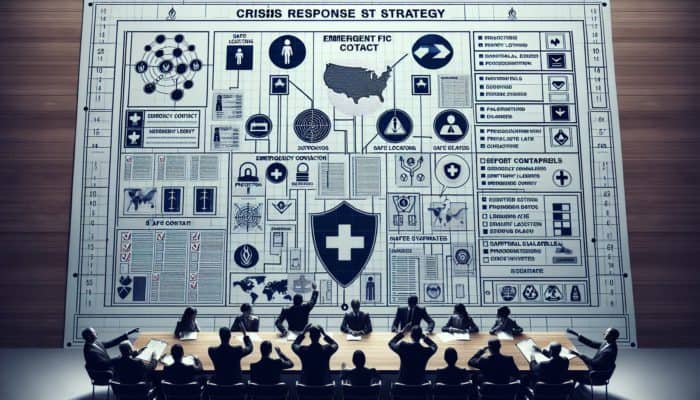Crucial Steps for Effective Crisis Preparedness
Developing a Comprehensive Crisis Response Strategy

Protecting Valuables in Crisis: Creating a thorough crisis response strategy is vital for effectively safeguarding your valuables during any unforeseen crisis. This strategy should encompass essential elements such as a list of emergency contacts, designated safe locations, and clear, actionable procedures for protecting your possessions. An effective strategy integrates several key components, ensuring that everyone involved understands their specific responsibilities. Consider including the following crucial elements:
- Emergency contact list comprising phone numbers and addresses.
- Designate safe locations for storing valuables.
- Detailed procedures for both evacuation and securing items. are provided
- Regular drills to practice the established plan.
- Access to emergency resources such as local shelters and services is crucial.
- Communication protocols to follow during a crisis.
- Specific roles are assigned to each family member to ensure clarity.
- Inventory of valuables to keep track of important items.
By establishing this comprehensive plan, you lay a strong foundation for crisis preparedness, enabling swift and efficient action when necessary. Consistent training and discussions surrounding this plan will reinforce its significance, ensuring everyone remains well-informed and ready to respond.
Creating a Vital Emergency Kit
An emergency kit is essential for ensuring your valuables are well-protected during a crisis. This kit should encompass vital items that allow for prompt action and cater to immediate needs. When assembling your emergency kit, be sure to include the following critical items:
- Cash in small denominations for quick transactions.
- Important documents such as IDs and insurance papers.
- Portable valuables like jewellery and heirlooms.
- Basic first aid supplies to address injuries.
- Flashlight and batteries for illumination during power outages.
- Non-perishable food and water to sustain you during emergencies.
- Chargers and backup power sources for devices to maintain communication.
- Keep the personal emergency contacts list close at hand.
Having these essential items readily available guarantees that you can swiftly address any situation and secure your valuables effectively. Regularly checking and updating your emergency kit to account for expired items or changes in your needs is crucial. Being prepared with a well-stocked emergency kit not only protects your valuables but also instills confidence in your crisis management capabilities.
Instructing Family Members on Crisis Strategies
Educating your family about the crisis response strategy is critical for ensuring effective action during any crisis. Each member should have a clear understanding of the plan and their individual roles in safeguarding valuables. Here are some valuable educational tips for family members:
- Conduct regular family meetings to discuss the crisis strategy.
- Practice drills to reinforce understanding and execution of the plan.
- Share information about potential risks that are specific to your area.
- Encourage open discussions about safety concerns and questions.
- Assign specific roles and responsibilities to each family member.
- Highlight the importance of remaining calm and focused during crises.
- Utilise visual aids, such as maps or diagrams, to clarify procedures.
- Promote a supportive environment where questions and suggestions are welcomed.
By fostering a culture of preparedness, families can ensure that everyone is equipped to respond effectively in a crisis. This collective knowledge empowers each member to take decisive action, thereby protecting both themselves and their valuables during emergencies.
Recognising Potential Risks in Your Environment

Assessing potential crisis scenarios involves identifying risks that could adversely affect your valuables. By comprehensively understanding these risks, you can develop appropriate strategies to mitigate them effectively. Here are some common risks to consider:
- Natural disasters such as floods, earthquakes, and hurricanes.
- Artificial crises, including civil unrest and terrorism.
- Economic downturns that lead to financial instability.
- Theft or burglary may occur during an emergency.
- Technological failures, including power outages and cyber-attacks.
- Health crises such as pandemics or epidemics.
- Transportation disruptions are affecting evacuation processes.
- Local infrastructure failures include road closures and a lack of services.
Regularly reviewing these potential risks allows you to adapt your crisis plan proactively. Being aware of these risks enables you to take preventive measures to ensure your valuables remain protected, even under challenging circumstances. This thorough understanding of potential threats serves as the groundwork upon which you can build effective response strategies.
Consistently Reviewing and Updating Your Plans
To ensure that your crisis response strategy remains effective, regular reviews and updates are essential. This vital practice keeps you prepared for any situation that may arise and ensures your strategies are relevant and practical. Key aspects to review and update include:
- Contact information for emergency services and family members.
- Inventory of valuables and their specific locations.
- Contents of emergency kits and their expiration dates.
- Local risk factors and any environmental changes.
- Family member roles and responsibilities.
- Technology updates include security systems and communication tools.
- Lessons learned from past crises or drills.
- Changes in personal circumstances, such as new family members or relocations, can occur.
Conducting these reviews regularly not only strengthens your preparedness but also reinforces the importance of crisis management within your household. By updating your plans consistently, you can be assured that you are ready to protect your valuables when it matters most.
Expert Insights on Safeguarding Valuables During a Crisis
What Are the Most Common Crisis Scenarios That Affect Valuables?

Understanding the different types of crises that could impact your valuables is essential for effective preparation. Common crisis scenarios include natural disasters such as hurricanes and earthquakes, which can cause significant physical damage to your property and increase the risk of theft. For instance, during Hurricane Katrina, many valuables were lost due to flooding or looting amidst the ensuing chaos. Similarly, economic downturns can result in financial uncertainty, affecting the value of investments and making personal property more vulnerable to theft as individuals face desperation.
Furthermore, civil unrest can escalate rapidly, leading to property damage and theft. For example, during protests in various cities globally, businesses have been targeted, underscoring the importance of securing physical assets. Other crises, such as cyber threats, can jeopardise digital valuables, making it imperative to protect online accounts and assets. By recognising these scenarios, individuals can better tailor their crisis response strategies to safeguard their valuables effectively.
How Can Experts Assist in Crisis Situations?
Engaging with professionals can significantly enhance your ability to protect your valuables during a crisis. Experts in security, emergency response, and crisis management offer valuable insights into effective strategies and technologies. To leverage their expertise, consider taking these actionable steps:
- Consult with security professionals to assess your home or business.
- Engage disaster recovery specialists to devise a recovery plan tailored to your needs.
- Attend workshops or seminars focused on crisis management to enhance your knowledge.
- Establish relationships with local emergency services for guidance and support.
- Seek legal advice on safeguarding assets during crises to understand your rights.
- Utilise insurance consultants to ensure comprehensive coverage for your valuables.
- Consider hiring a crisis management team for high-risk situations to ensure professional support.
- Network with community organizations focused on emergency preparedness for additional resources.
By collaborating with experts, you gain access to advanced knowledge and strategies that enhance your ability to protect your valuables. Their insights can help refine your crisis response plans, ensuring that you are both proactive and well-prepared.
What Are the Best Practices for Effective Crisis Management?
When it comes to managing crises and protecting your valuables, adhering to best practices is essential. Experts recommend several strategies that have consistently proven effective over time. Firstly, conducting a thorough risk assessment enables you to identify potential vulnerabilities in your security measures and response strategies. Secondly, establishing a clear communication plan ensures that all family members are informed and can act quickly during emergencies.
Utilising technology to bolster security measures is another best practice. Smart home systems, for instance, can provide real-time alerts during unauthorized access, enabling immediate action. Additionally, having a credible emergency contact and backup plan can streamline processes during crises. Regularly testing these systems and plans reinforces their effectiveness and allows for timely adjustments.
Establishing a strong support network within your community also proves invaluable. Foundations built on mutual assistance enhance your resources and provide support during crises. By implementing these best practices, you build resilience against various crisis scenarios, ensuring the safety of your valuables.
What Essential Preparations Should Be Made Before a Crisis?
Preparation is paramount when it comes to protecting your valuables before a crisis strikes. Essential steps include creating a detailed action plan, conducting risk assessments, and assembling emergency kits tailored to your specific needs. Secure important documents, such as property deeds and identification, in a fireproof safe or a secure digital format, ensuring they are accessible when necessary.
Another vital preparation step is to inventory your valuables thoroughly. Documenting items with detailed descriptions and photographs facilitates easier recovery after a crisis. Moreover, reviewing insurance policies to ensure adequate coverage for valuable possessions can avert significant financial losses. Establishing exit strategies for your household will also help streamline the evacuation process if necessary. Prioritising these preparations fosters a culture of readiness and significantly enhances your ability to protect valuables during critical times.
How to Effectively Recover Valuables After a Crisis?
Recovering and restoring valuables post-crisis requires a structured approach to ensure efficiency and effectiveness. The first step involves assessing the condition of your possessions to identify what can be salvaged and what needs replacement. For example, if items have sustained water damage, immediate action, such as drying and cleaning, can mitigate long-term effects.
It's crucial to leverage insurance claims effectively, ensuring that you have documented proof of ownership and condition before the crisis. Engaging professionals for restoration services, particularly for valuable art or collectibles, can provide the expertise necessary to restore these items to their original condition. Meanwhile, maintaining open communication with local authorities regarding recovery efforts aids in navigating potential challenges during this phase.
Finally, updating your crisis protection plans based on the lessons learned during the recovery process will enhance your future preparedness. By taking these steps, you position yourself not only to recover but also to grow stronger in the face of adversity.
Implementing Effective Physical Security Measures
Installing Secure Storage Solutions for Your Valuables
To effectively protect your valuables, installing secure storage solutions is of utmost importance. Safes, lockboxes, and secure cabinets provide peace of mind and create a physical barrier against theft. When selecting storage options, consider factors such as size, security features, and ease of access. A fireproof safe, for example, not only protects items from theft but also from potential fire damage, making it a critical investment.
Moreover, assess the location of your storage solutions. Concealing safes in less obvious areas of your home can deter potential thieves. Additionally, utilising smart security features, such as biometric locks or digital keypads, enhances the overall security of your valuables. Considering off-site storage solutions, such as safety deposit boxes, can further safeguard high-value items from theft or damage.
By investing in these secure storage solutions, you create an additional layer of protection that complements your overall crisis management strategy, ensuring your valuables remain safe during emergencies.
Reinforcing Home Security Systems to Protect Against Theft
Upgrading your home security systems is crucial in protecting your belongings from theft during a crisis. Enhanced security measures not only deter potential burglars but also provide real-time alerts that enable swift action. Look for features such as motion detectors, security cameras, and alarm systems that integrate with your smartphone for remote monitoring.
Additionally, consider installing smart locks that allow you to control access to your home remotely. This technology can provide peace of mind, particularly during crises when the risk of theft may increase significantly. Regularly testing these systems ensures they function as intended and can alert you to security breaches promptly.
Collaborating with a security expert can further tailor your home security to meet your specific needs. They can provide assessments and recommendations that address vulnerabilities unique to your property. Investing in comprehensive home security strengthens your position in protecting valuables during times of crisis.
Utilising Decoy Tactics to Distract Potential Thieves
Implementing decoy tactics can be an effective strategy to distract potential thieves and protect your genuine valuables. By creating the illusion of accessibility to less valuable items, you can deter theft and minimise losses. For example, consider placing items that appear valuable in less secure areas while concealing the real valuables in secure storage.
Another tactic is to use decoy safes or lockboxes. These can be filled with inexpensive items that resemble your more valuable possessions, luring thieves away from the actual secured items. Additionally, employing visible security measures, such as signs indicating an advanced security system, can further dissuade potential intruders from attempting theft.
The key to successful decoy tactics lies in their execution. Regularly review your strategies to ensure they remain effective and that your real valuables are adequately protected. By creatively employing these tactics, you enhance the overall security of your possessions during crises.
Strategies for Digital Protection
Securing Your Digital Valuables Against Cyber Threats
In today's digital landscape, protecting your digital assets, such as cryptocurrencies and online accounts, is paramount during a crisis. To secure these valuables, start with robust password management. Use long, complex passwords and consider enabling two-factor authentication for added security. This additional layer requires more than just a password, significantly reducing the risk of unauthorized access.
Regularly updating your software and operating systems also mitigates vulnerabilities that cybercriminals may exploit. Investing in a reliable antivirus program provides continuous protection against malware and phishing attempts. Furthermore, consider using a hardware wallet for cryptocurrencies to keep them offline and secure from potential hacks.
By employing these best practices, you can effectively safeguard your digital valuables. Consistent vigilance and proactive measures ensure that your online assets remain protected, even during uncertain times.
Backing Up Important Data to Prevent Loss
Regularly backing up your data is essential for preventing loss during a crisis. Establishing a routine for consistent backups ensures that your important files and records are secure, allowing for quick recovery after an incident. Utilise both cloud storage and external hard drives for comprehensive backups, ensuring redundancy in your data protection strategy.
Determine the frequency of backups based on how often you update important documents and files. For critical data, consider implementing daily backups, while less crucial information may require weekly or monthly assessments. Additionally, keep your backup systems secure; encrypt sensitive data and ensure access controls are in place.
By developing a routine for data backups, you protect against the potentially devastating consequences of data loss during a crisis. This proactive approach not only safeguards your information but also streamlines recovery efforts, providing you with peace of mind.
Implementing Encryption Technologies for Enhanced Security
Employing encryption to safeguard your digital valuables prevents unauthorized access and enhances data security. Encryption transforms your data into a code, ensuring that only individuals with the appropriate decryption keys can access it. This is particularly crucial for sensitive information, such as financial records and personal identification.
Investing in encryption technologies for both stored and transmitted data is essential. For example, using encrypted communication platforms protects your conversations and sensitive information from interception. Additionally, utilising full-disk encryption on laptops and mobile devices adds a layer of security, preventing unauthorized access in case of theft.
The benefits of using encryption extend beyond mere security; they also foster trust and confidence in your digital interactions. By prioritising encryption, you ensure that your digital valuables are well-protected against potential threats.
Financial Safeguards During Crisis Situations
Diversifying Your Investments to Minimise Risk
Diversifying your investments is a critical strategy for minimising risk during economic crises. By spreading your assets across various investment classes, you reduce exposure to market volatility, thereby safeguarding your financial stability. Consider allocating funds to stocks, bonds, real estate, and alternative assets, each offering unique benefits and risk profiles.
For instance, during a recession, certain industries, such as utilities and consumer staples, may remain resilient, while others may suffer significant losses. Additionally, holding a mix of domestic and international investments can further buffer against localized downturns. This strategic approach enhances resilience and creates opportunities for growth even in challenging environments.
Regularly reviewing and adjusting your investment portfolio ensures that it aligns with your risk tolerance and financial goals. By actively managing your investments, you fortify your financial safeguards and protect your valuables during crises.
Maintaining Liquidity for Quick Access to Funds
Maintaining liquidity is vital for accessing funds quickly during a crisis. Keeping a portion of your assets in easily convertible forms, such as cash or short-term investments, ensures that you can respond promptly to emergencies. This liquidity allows for immediate purchases or repairs, protecting your valuables from further damage or loss.
Establishing emergency funds that cover at least three to six months of living expenses is prudent, as it provides a financial cushion during uncertain times. Additionally, consider keeping cash reserves on hand to facilitate transactions when electronic payment systems may be compromised.
Regularly assessing your liquidity position is essential to ensure that your financial resources align with your needs. By prioritising liquidity, you enhance your ability to protect your valuables and navigate crises with confidence.
Preventing Financial Fraud in Crisis Situations
Implementing measures to prevent financial fraud is essential during times of crisis, as criminals often exploit vulnerable situations. Start by monitoring your financial accounts regularly for any unauthorized transactions. Setting up alerts for unusual activity can help you respond quickly to potential fraud.
Educate yourself and your family about common scams that may arise during crises. This awareness allows you to recognise red flags and avoid falling victim to fraudulent schemes. Moreover, consider using secure payment methods and exercise caution when sharing personal information online.
Engaging with financial institutions to discuss fraud prevention measures also enhances your protection. They often provide resources and support to safeguard your accounts. By proactively addressing potential fraud risks, you ensure that your financial assets remain secure, even in turbulent times.
Proven Strategies for Safeguarding Valuables in Crisis Situations
What Are the Most Effective Strategies for Protecting Valuables?
To safeguard your valuables during a crisis, several effective strategies have emerged as best practices. One key approach involves creating a comprehensive emergency plan that includes specific measures for securing both physical and digital assets. This plan should outline how to respond to various scenarios, ensuring that you are well-prepared for any eventuality.
Additionally, investing in advanced security systems, such as smart alarms and surveillance cameras, enhances your ability to protect your valuables from theft. Regularly updating your crisis response plan allows you to adapt to emerging risks. Another strategy includes utilising community resources, such as neighbourhood watch programmes, which foster a collaborative approach to security.
By implementing these strategies, you create a robust framework for protecting valuables, significantly reducing the likelihood of loss during crises. This proactive stance not only mitigates risks but also builds confidence in your crisis management capabilities.
How Can You Adapt Your Strategies to Different Crisis Types?
Adapting your protection strategies to various crisis scenarios is essential for effective crisis management. For natural disasters, prioritise physical security measures, such as reinforcing your home and creating evacuation routes. This preparation ensures a swift response to environmental threats.
Conversely, during economic downturns, focus on financial safeguarding strategies. Diversifying investments and maintaining liquidity become paramount to weathering financial uncertainty. Additionally, in the event of civil unrest, enhancing physical security measures, such as reinforced doors and outdoor lighting, can deter potential intruders.
Regularly reviewing your protection strategies to account for changing risks and circumstances is crucial. This adaptability ensures that you are equipped to respond effectively to any crisis, safeguarding your valuables in the process.
What Are the Long-Term Benefits of Implementing These Strategies?
Implementing robust protection strategies for your valuables yields significant long-term benefits. Firstly, establishing a culture of preparedness within your household fosters resilience. Families that prioritise crisis management develop strong communication skills and a shared sense of responsibility, enhancing their ability to navigate future challenges.
Moreover, investing in security measures often results in cost savings over time. For instance, comprehensive insurance coverage, coupled with valuable asset protection, minimises potential financial losses. Additionally, fostering community connections through joint preparedness initiatives creates support networks that prove invaluable during crises.
The enduring advantages of these strategies extend beyond mere protection. They contribute to a mindset of proactive risk management, empowering individuals and families to face crises with confidence. By prioritising these measures, you build a foundation for long-term security and peace of mind.
What Role Does Technology Play in Protecting Valuables During a Crisis?
Technology plays a pivotal role in enhancing the security of your valuables during crises. Advanced security systems, including smart cameras and motion sensors, provide real-time monitoring and alerts, allowing for rapid responses to security breaches.
Additionally, leveraging technology for secure data storage and encryption safeguards digital valuables against cyber threats. Cloud services, particularly those with robust security features, offer a reliable way to back up important documents and sensitive information, ensuring accessibility even in emergencies.
Moreover, utilising communication apps enables families to stay connected during crises, allowing for coordinated efforts in protecting valuables. By integrating technology into your crisis management strategies, you strengthen your security posture and enhance your ability to safeguard your possessions effectively.
How Can Community and Networking Aid in Safeguarding Valuables?
Community support and networking are instrumental in safeguarding valuables during crises. Establishing networks of trusted individuals creates a system of mutual aid, where community members can share resources and information during emergencies. These networks enhance communication and coordination, allowing for a collective response to threats.
Participating in local preparedness programs fosters collaboration and knowledge sharing among community members. Engaging with organisations focused on emergency management provides access to valuable training resources and workshops, enhancing overall community resilience.
Furthermore, neighbourhood watch programs can deter criminal activity by fostering vigilance and accountability among residents. Building these networks not only strengthens community ties but also creates a supportive environment where valuables are better protected during crises.
Building Community and Network Support
Establishing a Strong Support Network
Establishing a support network of trusted individuals is crucial for effective crisis management. This network serves as a valuable resource during emergencies, providing assistance and guidance in protecting your valuables. Engage with neighbours, friends, and family to create a cohesive support system that can be activated when necessary.
Consider organising regular meetings or gatherings to discuss crisis preparedness and share resources. Developing a communication plan within your network ensures that everyone knows how to reach each other during emergencies. Additionally, pooling resources for emergency kits, supplies, or equipment can significantly enhance your collective readiness.
The benefits of a support network extend beyond immediate crisis response; they foster a sense of community solidarity. By building these connections, you create an environment where individuals feel secure, knowing they have support during uncertain times.
Engaging with Local Resources for Enhanced Support
Utilising local resources during a crisis can significantly enhance your ability to protect your valuables. Local emergency services, shelters, and community organisations often provide critical assistance and information during emergencies. Familiarising yourself with these resources ensures that you can access necessary support when needed.
Establishing relationships with local authorities, such as police and fire departments, can provide insights into community safety initiatives and emergency plans. Engaging with local non-profits focusing on disaster preparedness offers additional resources and training opportunities that can further bolster your crisis readiness.
Furthermore, participating in local workshops or training sessions can equip you with valuable skills and knowledge to enhance your crisis preparedness. By actively engaging with these local resources, you build a safety net that bolsters your crisis management capabilities.
Participating in Community Preparedness Initiatives
Joining community preparedness programs is an effective way to enhance your crisis readiness and protect your valuables. These programs often focus on training individuals in emergency response techniques, risk assessment, and resource management. By participating, you acquire valuable knowledge and skills that strengthen your ability to respond during crises.
Community preparedness programs also foster collaboration among residents, creating a supportive environment where individuals can share ideas and resources. Engaging with these initiatives builds a culture of preparedness within your community, ensuring that everyone is equipped to handle emergencies effectively.
Moreover, these programs often provide access to local resources and support networks, enhancing your ability to safeguard valuables during crises. By actively participating, you contribute to a resilient community that prioritises safety and security.
Addressing Psychological and Emotional Preparedness
Managing Stress Effectively During a Crisis
Learning techniques to manage stress during a crisis is essential for making clear decisions to protect your valuables. High-stress situations can impair judgment, leading to hasty actions that may endanger your possessions. Effective stress management strategies, such as mindfulness practices and deep-breathing exercises, can help you maintain clarity and composure.
Establishing a support system allows you to share concerns and seek guidance during difficult times, thereby reducing feelings of isolation. Consider engaging in physical activities or hobbies that promote relaxation, providing a mental break from crisis-related stress.
Developing a crisis management plan also contributes to stress reduction. Knowing you have a structured approach to safeguarding your valuables fosters confidence and security. By prioritising stress management, you enhance your ability to protect your possessions and respond effectively during crises.
Preparing Mentally for Various Crisis Scenarios
Mentally preparing for different crisis scenarios ensures that you can respond effectively and protect your valuables. Visualisation techniques can be particularly helpful, allowing you to rehearse your responses to potential emergencies mentally. Imagine yourself executing your crisis response plan, reinforcing your readiness and confidence in your ability to handle the situation.
Additionally, educating yourself about common crisis scenarios helps demystify potential threats and reduces anxiety. Awareness of local risks and the steps to take in response empowers you to act decisively when faced with challenges.
Encouraging open discussions about fears and concerns within your family promotes mental readiness. By addressing these topics, you build a shared understanding of crisis response, ensuring everyone feels prepared and supported. This mental preparedness enhances your ability to navigate challenges effectively and protect your valuables.
Supporting the Emotional Well-Being of Your Family
Ensuring your family's emotional well-being during a crisis is vital for maintaining focus on protecting valuables. High-stress situations can lead to anxiety and panic, detracting from effective decision-making. By fostering a supportive environment, you can help family members cope with the challenges of a crisis.
Encourage open communication about feelings and concerns, allowing everyone to express their emotions freely. Providing reassurance and maintaining a sense of normalcy during uncertain times can alleviate stress and promote resilience among family members. Regular family check-ins can help identify any underlying issues that may need attention.
Additionally, engaging in family activities that promote bonding and relaxation can counterbalance the stress of the crisis. By prioritising emotional well-being, you enhance your family's collective ability to protect valuables and navigate challenges effectively during emergencies.
Post-Crisis Recovery and Assessment of Valuables
Evaluating Damage to Valuables After a Crisis
Assessing the condition of your valuables after a crisis is a critical step in determining your next actions. Begin by documenting the extent of the damage through photographs and written descriptions. This documentation is essential for insurance claims and recovery efforts, providing proof of the situation.
Carefully identify which items can be restored and which may need replacement. For valuable items, consider consulting with restoration professionals who specialise in repairing damage. Their expertise can provide valuable insights into the feasibility of restoration and the associated costs involved.
Additionally, conducting a thorough inventory of your possessions can help you understand the full scope of losses. This evaluation not only aids in recovery efforts but also informs updates to your crisis protection plans. By systematically assessing damage, you position yourself for effective recovery and restoration of your valuables.
Rebuilding and Restoring Your Valuables
Taking steps to rebuild and restore your valuables following a crisis is essential for recovery. Once you have assessed the damage, prioritise items based on emotional and financial value. For significant possessions, consider engaging professionals who specialise in restoration, ensuring that they receive the necessary care for successful recovery.
Additionally, maintain an open line of communication with your insurance provider throughout the restoration process. Understanding what is covered under your policy and working closely with claims adjusters can expedite recovery efforts and ensure a smoother process.
For items that cannot be restored, explore options for replacement or alternative solutions. This flexibility allows you to regain a sense of normalcy while managing any emotional attachments to lost items. By actively pursuing restoration and rebuilding efforts, you reinforce your resilience and commitment to safeguarding your valuables in the future.
Updating Your Crisis Protection Plans Based on Experience
Reviewing and updating your crisis protection plans based on lessons learned from past experiences is crucial for future preparedness. After recovering from a crisis, take the time to reflect on what worked well and what could be improved. Identify any gaps in your plan and make necessary adjustments to enhance its effectiveness.
Consider engaging family members in this process, allowing everyone to share their insights and suggestions. This collaborative approach fosters a sense of ownership and reinforces the importance of preparedness within your household. Additionally, review any local changes to risks or resources that may impact your crisis response.
Regularly updating your plans ensures that they remain relevant and effective. By learning from past experiences and adapting your strategies, you can enhance your ability to protect your valuables during future crises, creating a stronger foundation for resilience.
Frequently Asked Questions (FAQs)
What should I include in my comprehensive crisis response plan?
Your crisis response plan should incorporate emergency contact information, designated safe locations, detailed evacuation procedures, and specific roles for family members. Regularly reviewing and practicing this plan ensures that everyone is well-prepared for any situation.
How do I effectively create an emergency kit?
Assemble your emergency kit with cash, important documents, portable valuables, non-perishable food, water, first aid supplies, and a flashlight. Regularly check and update the kit to ensure all items are current and ready for use.
Why is it important to educate family members about crisis plans?
Educating family members about crisis plans ensures that each individual knows their specific roles and responsibilities, promoting swift and effective action during emergencies.
How can I identify potential risks in my area?
Assess local environmental factors, historical crises, and community resources to identify potential risks. Regularly reviewing this information helps you adapt your crisis response plan accordingly.
What are the best strategies for recovering valuables after a crisis?
After a crisis, assess damage, document losses, engage with restoration professionals, and communicate with your insurance provider to facilitate a smooth recovery process.
How does investing in home security systems protect my valuables?
Advanced home security systems deter theft and provide real-time alerts during emergencies, enabling quick responses to potential threats to your valuables.
What role does technology play in safeguarding digital assets?
Technology enhances the security of digital assets through encryption, secure data storage, and real-time monitoring, protecting against unauthorized access and cyber threats.
Why is community support important in crisis scenarios?
Community support fosters collaboration, resource-sharing, and a sense of solidarity, enhancing overall preparedness and security in protecting valuables during crises.
What are effective stress management techniques during a crisis?
Effective stress management techniques include mindfulness practices, open communication, physical activities, and establishing a robust crisis management plan to foster confidence in your actions.
How can I regularly update my crisis protection plans?
Regularly review your crisis protection plans after drills or actual crises, gathering input from family members and assessing changes in local risks or resources to ensure ongoing effectiveness.
Explore our journey on X!
Grid-Down Heating: Essential Strategies
Exploring Effective Strategies for Heating During Power Outages What Is Grid-Down Heating and How Does It Work? Grid-Down Heating: Grid-down heating encompasses a range of innovative and traditional heating solutions that are employed when the electrical grid is incapacitated due to power outages. In these circumstances, reliance on conventional heating systems becomes impractical, prompting the need […]
Preparing for Earthquakes: Essential Tips and Strategies
Comprehending the Risks Associated with Earthquakes What Are the Primary Causes of Earthquakes? Preparing for Earthquakes: Earthquakes predominantly arise from the dynamic movements of tectonic plates, which are colossal sections of the Earth's crust that rest upon the semi-plastic mantle beneath. These tectonic plates can collide, separate, or slide against one another, generating friction that […]
Distress Signal Methods: Essential Techniques for Safety
Comprehensive Guide to Distress Signal Methods for Emergency Situations What Are Distress Signals and Their Importance? Distress Signal Methods: Distress signals serve as vital communication tools that convey emergencies and summon assistance across diverse scenarios. They function as a beacon of hope for those in danger, effectively connecting individuals in distress with potential rescuers. These signals […]
City Power Outage Prep: Essential Strategies
Understanding the Importance of Being Prepared for Power Outages Why Is It Essential to Prepare for Power Outages? City Power Outage Prep: Recognising the importance of being prepared for power outages is critical for reducing risks and ensuring safety during emergencies. Power outages can arise from various factors, including severe weather, equipment failure, or natural […]







